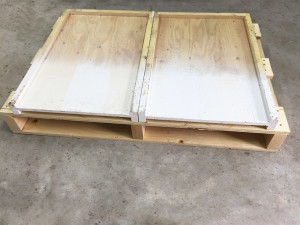Painting a Beehive
Why Paint?

We have a tradition of painting our supers and since we’ve never had any issues with paint, we continue to do so.
We acknowledge that many beekeepers wax dip their equipment. I will not argue one way or the other because there are many advantages to wax dipped equipment including the killing of nosema spores in winter dead outs etc. Wax dipping is popular is due to the moisture inside the wood evaporating and is replaced with wax. These boxes no longer rot, and can last 50 years or more. But they don’t look that great; they quickly develop an old wooden look in 5 years.
Painting Tips
When you paint, it’s important to know that nothing that comes into contact with the inside of the beehive requires paint. Bees will wax it over in no time and it’s not going to be an issue. You also don’t want to expose the inside of a hive to paint; it’s not necessary. That means the inside of an outercover doesn’t require paint. The inside of supers and bottom boards do not require paint. I do paint the bottom side of bottom boards because they are exposed to the elements.
When you paint honey supers, stack them up as high was you can paint. About 7 -8 supers high should be doable depending on your height. The boxes should be inverted so you can reach the inside if the handle. The super handles are easy to miss due to the angles. We prime everything once and then add on two additional thick coats of Acrylic Latex HP 2000 paint from Sherwin Williams. It’s a top quality paint and we have never had any issues from the bees. There is no need to use ‘Bee Safe’ paint as long as you give your paint a couple days to dry and air out before using the equipment.
Beekeeper White

I’ll admin it, I’m biased towards using white paint. I like consistency so I paint everything the same colour but it’s not necessary. It’s probably better for the bees to have multiple colours in your yard to aid navigation, especially in nuc yards or where queens mate. You can always compensate by not placing mating nucs too close together etc.
While white may look plain, I feel it’s the best colour for beehives in summer. Darker colours attract more sunlight and will heat the hives a little more than white colours will. While it’s advantageous in summer, perhaps not so much in early spring where a little extra heat could help. It’s a give and take situation and perhaps it’s not that important.
While it gets figured out, I’ll continue painting white, because if it ain’t broken, why fix it?